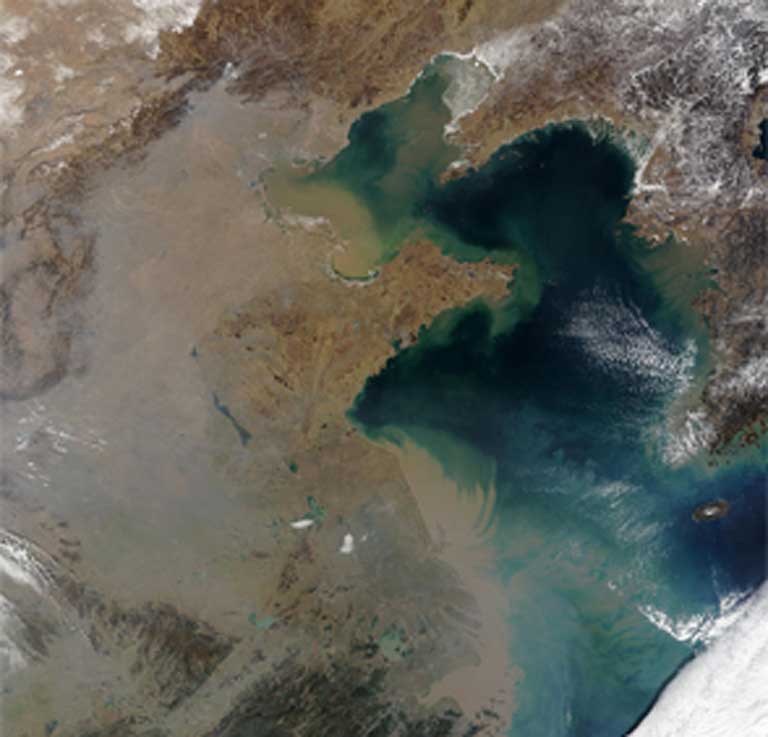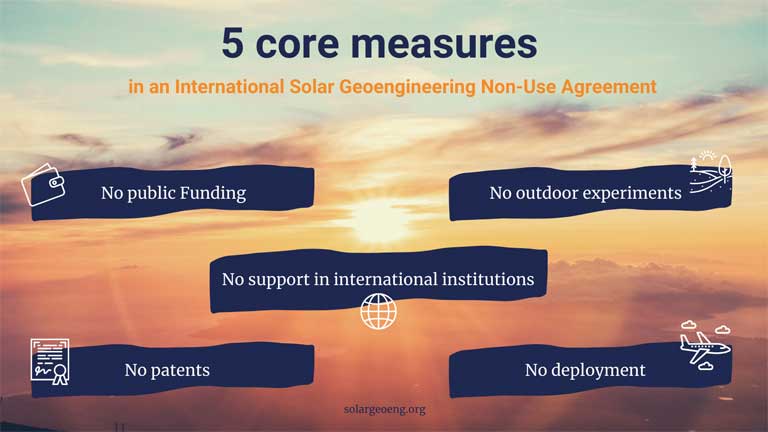
- Scientists are calling on political institutions to place limits on solar geoengineering research so that it cannot be deployed unilaterally by countries, companies or individuals.
- Long-term planetary-level geoengineering interventions of this kind are unprecedented and extremely dangerous, say the academics behind the letter, and should not therefore be experimented with outdoors, receive patents, public funds or international support.
- Solar geoengineering’s leading proposal — injecting billions of aerosol particles into the Earth’s stratosphere — could have severe, unintended and unforeseen consequences. Modelling suggests that it may cause drying in the Amazon rainforest
- In addition, if solar geoengineering were deployed, it would need to be maintained for decades. Sudden discontinuance would result in Earth facing what scientists call termination shock, with a sudden temperature rise due to existing atmospheric carbon emissions which would have been masked by cooling stratospheric aerosols.
Blocking the sun’s rays with an artificial particle shield launched high into Earth’s atmosphere to curb global temperatures is a technological fix gaining traction as a last resort for containing the climate crisis — but it needs to be stopped, wrote a coalition of over 60 academics in an open letter and article released in the WIREs (Wiley Interdisciplinary Reviews) Climate Change online publication on January 17.
“Some things we should just restrict at the outset,” lead author Aarti Gupta, a professor of Global Environmental Governance at Wageningen University, told Mongabay. Gupta placed solar geoengineering in the category of high-risk technologies, like human cloning and chemical weapons, that need to be off-limits. “It might be possible to do, but it’s too risky.”
The color of the sky could change. The chemical composition of the ozone layer and oceans may be permanently altered. Photosynthesis, which depends on sunlight, may slow down, possibly harming biodiversity and agriculture. And global weather patterns could change unpredictably.
Despite the potential dangers, no mechanism exists today to stop an individual, company or country from launching a solo mission, said Gupta. To prevent this, the open letter suggests five urgent protective measures: no outdoor experiments, no implementation, no patents, no public funding, and no support from international institutions such as the United Nations.

Solar geoengineering: Too much risk
More than 60 academics signed the letter, including Dirk Messner, the president of the German Environment Agency; Cambridge University climatologist Mike Hulme; Åsa Persson, the Stockholm Environment Institute’s research director; and award-winning author Amitav Ghosh.
Scientists know that aerosol particles can temporarily cool the earth’s surface. Fine ash from the 1991 eruption of Mount Pinatubo — the largest volcanic eruption in the last 100 years — lowered global temperatures by 0.5 degrees Celsius (0.9°F) for almost two years.
But to offset global warming caused by carbon emissions, an artificial aerosol particle shield would need to be continuously replenished over several decades, running contrary to a goal of the United Nations Framework Convention on Climate Change to prevent “dangerous human interference with the climate system.”
If stopped abruptly, the protective aerosol cloud’s masking cooling effect would quickly abate allowing all the accumulated greenhouse gases in the atmosphere to hit the planet in one rush. Global temperatures could suddenly skyrocket four to six times faster than recent climate change, according to a 2018 Yale study published in Nature Ecology & Evolution.
“How can we give a guarantee to future generations that our governance systems are so robust that there would be no termination shock?” questioned Gupta.
According to the policy experts who issued the open letter, international consensus spanning several generations is simply not democratically feasible among all the world’s governments.

A journey from science fiction to real science
Large-scale geoengineering proposals bordered on science fiction for decades. But in recent years, these technologies have seeped into mainstream climate discussions as a last-ditch policy option, garnering attention and millions in funding.
In 2019, the United States Congress granted the National Oceanic and Atmospheric Administration (NOAA) $4 million for solar geoengineering research. In March 2021, the U.S. National Academies of Sciences, Engineering, and Medicine, called for the country to spend an additional $100 to $200 million. Billionaire Bill Gates has made personal donations to the world’s leading solar geoengineering research unit at Harvard University.
David Keith, one of the main researchers leading the solar geoengineering initiative and an applied physics professor at Harvard, responded to the open letter, saying he shares concerns about uncertainty, moral hazard and governance challenges, but disagrees with a permanent de facto ban on solar geoengineering.

“It’s hard to justify a permanent non-use agreement on tech that — according to literature and summaries by IPCC [the UN Intergovernmental Panel on Climate Change] and U.S. National Academy [of Science] — might substantially reduce climate risks,” Keith told Mongabay via email. “It seems an overclaim to suggest that we should block research on potentially useful technologies because governance mechanisms are not ideal.” He added that governance concerns also arose with mRNA technology responsible for several Covid-19 vaccines, and with the development of the Internet, but neither fear justified a permanent ban.
Last year, the Harvard team was forced to cancel their first outdoor geoengineering test, to be done in partnership with Sweden’s Space Corporation, following a Swedish public protest led by the Indigenous Sami people.
“You can model it and conduct experiments, but we can only know the final effects of planetary-scale solar geoengineering after its deployment,” warned Frank Biermann, professor of global sustainability governance at Utrecht University and one of the letter’s initiators, in a telephone interview; he supported the Sami-led opposition against Harvard’s high-altitude test flight. “It is an extremely risky proposition,” he concluded.

Possible impacts on planetary boundaries
Solar geoengineering would reduce the amount of solar radiation reaching the planet’s surface, and thereby have profound effects. The planet would cool, but not evenly. The Amazon region might become dryer and warmer, according to computer models, enhancing the likelihood of major forest fires and increased rainforest die-off, leading to a potential massive release of formerly sequestered carbon.
This huge Amazon carbon release to the atmosphere would spell disaster for the planet, dramatically increasing global warming while reducing biodiversity. These impacts could end up being worse than moderate climate change IPCC scenarios.
Depending on the type of aerosol particles used to form the shield, deployment could also either thin out or add to the ozone layer, with unknown consequences. Without a sharp reduction in carbon emissions, ocean acidification would continue to worsen.

Reducing solar radiation reaching the earth’s surface would also be counterproductive, thwarting solar energy production, one of the most promising alternatives to fossil fuels.
While proponents of solar geoengineering argue that this new technology can only be successful when accomplished alongside aggressive decarbonization, critics believe its deployment would jeopardize carbon emission reduction efforts. They contend that industry lobbyists, climate change denialists, and some governments would politically weaponize a geoengineering solution, positioning it as a way to delay carbon regulation.
“The best option is to keep the genie in the bottle and not start with these very dangerous technologies,” said Biermann. “We need to focus not on these fantasies of nonexistent technologies, but on the real problem at hand, which is decarbonization.”
Banner image: A solar geoengineering technology test flight with a stratospheric balloon was planned by a Harvard research unit in partnership with the Swedish Space Corporation last year. It was postponed following public outcry. Image courtesy of the Swedish Space Corporation.
Citations:
Biermann, F., Oomen, J., Gupta, A., Ali, S. H., Conca, K., Hajer, M. A., … VanDeveer, S. D. (2022). Solar geoengineering: The case for an international non-use agreement. Wiley Interdisciplinary Reviews: Climate Change, e754. doi: 10.1002/wcc.754
Trisos, C.H., Amatulli, G., Gurevitch, J. et al. Potentially dangerous consequences for biodiversity of solar geoengineering implementation and termination. Nat Ecol Evol 2, 475–482 (2018). doi: 10.1038/s41559-017-0431-0
FEEDBACK: Use this form to send a message to the author of this post. If you want to post a public comment, you can do that at the bottom of the page.
Efforts to dim Sun and cool Earth must be blocked, say scientists
Source: Trends News

0 Comments